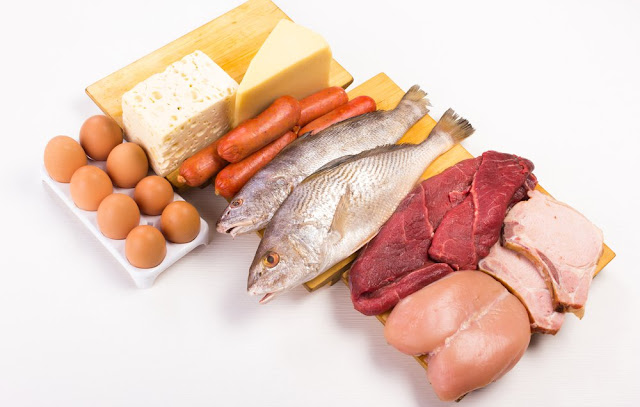You are what you eat- and what your food eats!
You've probably heard the phrase "you are what you eat." Right? Well guess what? It's true! Our bodies are constantly rebuilding themselves. This doesn't just occur after a workout or when healing from a cut, bruise or burn, but on a cellular level every second, of every day through a process called autophagy. Autophagy maintains homeostasis aka- normal bodily function. It does this by a process called protein degradation; the turnover of destroyed cell organelles creating new cell formation.
Huh?
The quality of your rebuilding process is reliant on your fuel source aka- FOOD. Think of your body like a high performance (hopefully) race car. You wouldn't dream of rolling up to pump #7 and saying "fill it up- regular!" You'd be using high octane, quality fuel to keep your vehicle going. You follow me so far?
This is why your food choices are so important. It's your fuel. It's important to understand the following concept- you are what you eat, and what your food eats.
It's no secret, I'm a meat-eater. I love steak, rack of lamb, homemade meatballs, BACON. It's my main source of protein 90% of the time. Working two jobs, writing a blog, having a passion for reading, cooking, music, training martial arts, throwing around kettlebells and binge watching Netflix late into the night requires a lot of fuel, consistent mental clarity and being able to recover the right way.
I shamelessly post pictures of my breakfast, lunch and dinner which usually reads something like "TONIGHT'S POST-WORKOUT!- grass-fed steak with grass-fed butter and grass-fed water on a grass-fed plate after my grass-fed workout, kickin it with my grass-fed girlfriend watching grass-fed House of Cards." I obviously have no problem rolling my eyes at myself, so you shouldn't either, but I digress.
A report published by the Food and Drug Administration in February, 2011 found that out of 480 samples of ground turkey, pork chops, ground beef, and three cuts of chicken from U.S. supermarkets, over 50% had antibiotics present. Another report from the FDA cited that approximately 80% of the antibiotics used in the United States are given to farm animals, with 20% being used to treat infections in people, their original purpose.
You won't see this on the package, but you will see "No hormones or antibiotics used!" and a higher price tag if a company is able to avoid having to feed them to their animals.
But why are the animals sick so f***** sick?
Two reasons; Environment and diet.
Factory Farming
Factory farming is scary. I mean literally- a horror show. A "factory farm" is a large-scale industrial operation that houses thousands of animals raised for food. Animals are fed corn, wheat and soy that are covered in mold and grown unregulated with large amounts of pesticides. The mold and pesticides can remain in their bodies and hold the potential to be passed on to the people who eat them. Ever get feel sick for no reason, even though you take "pretty good" care of yourself? Scarey. With horrendous consequence; implementing antibiotics and growth hormones to the animals' regimen can keep them alive for longer and make them fatter, maximizing a factory's production.
Organizations like PETA and the folks over at Do Something have done a great job of portraying the way factory animals are treated on a daily basis and if you've got tough skin, I'd recommend looking into it. Packing boatloads of cows, chickens and pigs into small cages by the dozen in one place produces much more waste than the surrounding areas can handle. As a result, factory farms are associated with various environmental hazards, such as water, land and air pollution.
It all sounds bad, but the alternative is ethical farming. When cows, chickens, lamb and pigs are able to live their lives in their natural environment, it is not only better for the environment but for the animal and ultimately the consumer buying their meat from that farm. Cows naturally eat grass, not grains. They "graze". Chicken's eat vegetables, fruits, flowers, grass and even bugs. They naturally thrive in pastures, not cages. Pigs and lamb, the same. When you delve into the difference in nutrition between grass-fed beef, for example, versus a factory farmed (grain-fed) steak- the results are pretty outstanding.
From AuthorityNutrtion.com;
Regular grain-fed beef is loaded with Vitamin B12, B3 and B6. It is also very rich in highly bioavailable Iron, Selenium and Zinc. Meat contains some amount of almost every nutrient that humans need to survive.
Meat also contains high quality protein and various lesser known nutrients like Creatine and Carnosine, which are very important for our muscles and brains.
However, grass-fed beef is even more nutritious than that::
- Vitamin A: Grass-fed beef contains carotenoid precursors to Vitamin A, such as beta-carotene.
- Vitamin E: This is an antioxidant that sits in your cell membranes and protects them from oxidation. Grass-fed beef contains more.
- Micronutrients: Grass-fed beef also contains more Potassium, Iron, Zinc, Phosphorus and Sodium.
It doesn't come as a surprise that a happy, healthy cow is better for you than a sick, caged cow. Even dairy from grass-fed cows have been shown to be superior to the nasty homogenized, heat damaged milk that we've been drinking most of our lives. Pastured chicken, pigs and lamb share similar results when compared with their caged counter parts.
Economy
Standard chicken costs an average of $1.50 per pound while the price for organic, free-range chicken is $2.69 a pound (Trader Joe's), and $4.99 per pound online (Fresh Direct). Whole Foods sells boneless, skinless organic chicken breasts for $8.99 per pound. And it's not unusual to pay more than $10 per pound for similar organic chicken breasts at upscale butcher shops. Woah.
Grass-fed beef shared similar results;
| Conventional | $4.95 per pound |
| Without antibiotics | $6.55 per pound |
| Organic | $5.62 per pound |
| Grass-fed | $7.38 per pound |
| Grass-fed organic | $7.83 per pound |
Source; http://www.consumerreports.org/
Ultimately, it is up to you whether or not the investment is worth it. Luckily, there are some ways to cut the price down if you are looking to "upgrade" your fuel source. Let's get into that.
Hacking the Economics of Ethically-Raised Meat
Look for Sales. The first option may also be the most obvious. In my neck of the woods (Staten Island, NY), grass-fed beef and pastured chicken is in high enough demand that it exists, but not popular enough to be flying off the shelves- this might be common in your area too. The ShopRite near me, sells 100% grass-fed ground beef for $5.99 a lb that towards the end of the week will often drop to $4.99 or even $3.99 a lb, which I'll always stock up on, especially at $3.99. Steal.
Buy in Bulk. Like I said, if I see a sale, I'm loading up. You can also go to a farmer's market that sells grass-fed products and ask about bulk or wholesale pricing. If you do use a lot of meat and are looking to upgrade your diet, this can be a great investment if you can find the right source- as long as you have a freezer.
Buy Online. This option is similar to buying in bulk. It takes a little more effort on the farmer's part to ship pounds of meat at proper temperature across the country so they will often require a minimum purchase of 5-10 lbs or more. In a day in age where the internet economy is "boomin," this option makes sense financially. There is definitely competition out there, which for us means, better sales, better prices. U.S. Wellness Meats is a great option. They carry a wide range of products from grass-fed sliders to organic bacon, sausage, steak, ribs and even jerky. They have pastured chicken and pork and ship all-over the US- no monthly commitment.
Subscription Service. ButcherBox.com is awesome. They have a variety of packages that include 100% Grass Fed Beef, Free Range Organic Chicken and Heritage Breed Pork- all ethically fed, raised and shipped to your door for $129 a month. I'd highly recommend signing up for their email list and waiting a little while before placing an order. They send promotions and sale codes out all the time and literally give stuff away, IE bacon, rib-eye steaks, ribs, etc. All good stuff.
If you can fit it into your budget, upgrading your meat can be a great way to optimize your health and help the world be a slightly better place. Hopefully you found this grass-fed information helpful!






Comments
Post a Comment